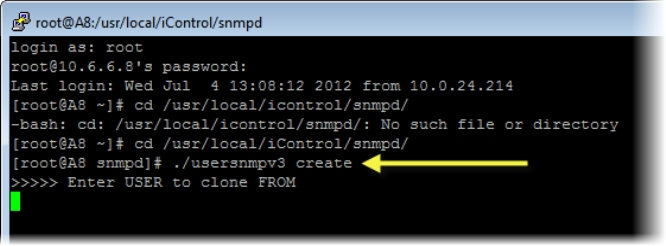Creating SNMPv3 User Profiles
REQUIREMENTS: |
Make sure you meet the following conditions before beginning this procedure: |
• Default user templates currently exist on this Application Server. To verify that they exist, perform the list command. ( click HERE). The SNMPv3 commissioning procedure has already been performed once for this Application Server ( click HERE). |
• You have logged into your Application Server with a PuTTY secure shell and have changed directories to iControl’s snmpd directory ( click HERE). |
• [RECOMMENDED]: You are performing this procedure as a task within the context of an approved workflow ( click HERE). |
1. In your PuTTY secure shell, create a new user profile:
./usersnmpv3 create
[ Graphic ]
System response after create command
2. Specify the user template to clone from.
3. Specify the name you would like to assign to the new user profile.
4. Change the new user profile’s authentication and privacy passwords by performing the following sub-steps:
a) Type:
./usersnmpv3 password
System Response: The system prompts you for the name of the new user profile.
b) Type the new user profile name.
System Response: The system prompts you for the existing authorization password.
c) Type the existing authentication password.
System Response: The system prompts you for the user security level.
d) Type the number corresponding to the security level of this user.
System Response: The system prompts you for the user’s privacy password.
e) Type the user’s privacy password (if applicable).
System Response: The system prompts you for the type of password change.
f) Type the number corresponding to the type of password change you would like to do.
System Response: The system prompts you for a new authentication password.
g) Type the new authentication password.
System Response: The system prompts you for a new privacy password.
h) Type the new privacy password.
System Response: If the password change operation is successful, the system returns a confirmation message.

